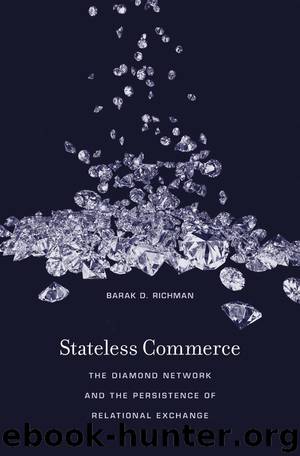Stateless Commerce: The Diamond Network and the Persistence of Relational Exchange by Barak D. Richman

Author:Barak D. Richman [Richman, Barak D.]
Language: eng
Format: epub
Publisher: Harvard University Press
Published: 0101-01-01T00:00:00+00:00
6
Lessons from Statelessness
Economic History, Ethnic Networks, and Development Policy
WHY ARE SO many diamond dealers Jewish? Does the concentration of Jewish merchants in the trade reveal anything about the diamond industry? And does Jewish success as diamond merchants reveal anything about Jewish economic performance in other industries throughout history?
Chapter 3, describing the family and Jewish community institutions that surround and support the diamond trade, concludes, “[The] two-pronged system of family-based reputation mechanisms and community-based enforcement institutions allows New York’s diamond merchants to organize reliable time-inconsistent exchange. It works because all players who are entrusted with another’s diamonds belong to one of the two categories and thus are subject to one of the two punishment devices. The system embodies what Yoram Ben-Porath (1980) called ‘the F-connection,’ where trade networks organized around families and friends (that is, community members) can execute implicit contracts that enjoy efficiencies unavailable to formal, arm’s-length transactions.” These diamond dealers, because of the community in which they live, are able to make credible promises that others cannot, and their credibility translates into the opportunity to obtain valuable credit for diamond purchases. In short, their community gives them a comparative advantage over other would-be dealers, and their community institutions appear to be necessary features for enabling community members to excel in the diamond industry.
This chapter explores some of the outer boundaries of this phenomenon. The success of Jewish diamond merchants reveals just one instance of how the interplay of industry and community institutions, of information mechanisms and power relations in insular communities, of industry rules and community standards, can influence economic outcomes. There is nothing exclusively Jewish about the institutional features described in Chapter 3—surely other communities offer noneconomic rewards for cooperative conduct and issue noneconomic sanctions to punish harmful behavior. Reciprocally, community enforcement mechanisms and social sanctions that induce community members to keep their promises can be economically beneficial in many industries outside the diamond trade. Understanding the community features that assist Jewish merchants in the diamond industry might inform broader questions about the institutional foundations of economic growth.
This chapter explores both sides of the complementarities that connect Jewish community institutions and diamond merchants. It investigates Jewish economic performance beyond the diamond industry, and it explores ethnic performance in the diamond industry beyond the Jewish community. It then explores whether these historical lessons have implications for modern development policy.
Download
This site does not store any files on its server. We only index and link to content provided by other sites. Please contact the content providers to delete copyright contents if any and email us, we'll remove relevant links or contents immediately.
Life 3.0: Being Human in the Age of Artificial Intelligence by Tegmark Max(4526)
The Sports Rules Book by Human Kinetics(3602)
ACT Math For Dummies by Zegarelli Mark(3570)
The Age of Surveillance Capitalism by Shoshana Zuboff(3435)
Blood, Sweat, and Pixels by Jason Schreier(3144)
Unlabel: Selling You Without Selling Out by Marc Ecko(2998)
Urban Outlaw by Magnus Walker(2953)
Hidden Persuasion: 33 psychological influence techniques in advertising by Marc Andrews & Matthijs van Leeuwen & Rick van Baaren(2797)
The Pixar Touch by David A. Price(2748)
Bad Pharma by Ben Goldacre(2738)
Project Animal Farm: An Accidental Journey into the Secret World of Farming and the Truth About Our Food by Sonia Faruqi(2668)
Brotopia by Emily Chang(2597)
The Content Trap by Bharat Anand(2499)
Slugfest by Reed Tucker(2427)
The Airbnb Story by Leigh Gallagher(2382)
Kitchen confidential by Anthony Bourdain(2325)
Coffee for One by KJ Fallon(2020)
Smuggler's Cove: Exotic Cocktails, Rum, and the Cult of Tiki by Martin Cate & Rebecca Cate(1997)
Beer is proof God loves us by Charles W. Bamforth(1939)
